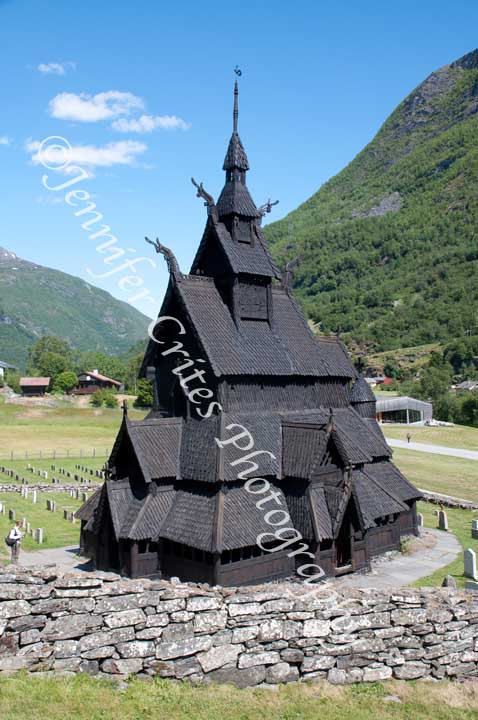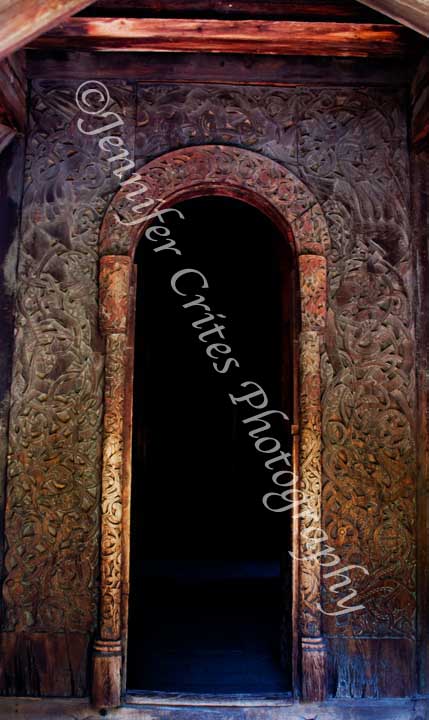It’s an ironic story line—after raiding and pillaging towns and villages in countries throughout the north Atlantic, Vikings returned home and went to church.
Perhaps they did, but if so, they didn’t attend services in a stave church—so named for its interior, weight-bearing pillars, or staves. There may be dragons on the roof, but stave churches weren’t built until after the Viking Age ended. That date is traditionally marked in England by the failed invasion attempt by Norwegian King Harald III, who was defeated by Saxon King Harold Godwinson in 1066. Ireland and Scotland note their own dates, predicated on victories against Vikings.
At one time there were more than a thousand stave churches throughout Europe. Most were built between circa 1130 and 1350 AD. Construction stopped when the Black Death started to spread through Europe, and congregating in small spaces became life threatening.
And the stave church is indeed a small space. So small, in fact, that most of its congregation had to stand—men and boys on the right, women and girls on the left. The elderly and sick could sit on benches along the walls.
Today only 28 stave churches survive, and all are in Norway where there is a long tradition of building in wood (remember those sturdy Viking ships). Earlier churches were built on often-soggy ground and succumbed to wood rot. Lesson learned. Stone foundations solved that problem.
While visiting the stave church in Borgund, I was surprised to see that it—like other stave churches—had no windows. The only light entered through a few small portholes high up on the walls. The altarpiece depicts Christ’s crucifixion. Animal masks adorn the south door, and serpents and dragon-like creatures decorate the main-door side panels and lintel. On the roof turrets, Christian crosses and dragonheads keep each other company. Old legends die hard I guess, and it seems that the parishioners were hedging their bets—honoring old gods and new.
I found it interesting that the timber used in construction of the church was most likely seasoned on the root, strategic cuts drawing the tar to the surface before the tree was felled. After construction and during renovations, additional tar was applied to protect the wood.
It was common to bury the dead under the church floor, but that practice stopped at the end of the nineteenth century thanks to the unpleasant smell. However, stillborn infants and babies who died before being baptized could not be buried in the consecrated ground of the churchyard. Tiny coffins were placed under the floor, even in recent times. It seems odd to me that the ground around the church was considered consecrated, but the ground under the church was not.
If you stand inside the church and look up, you’ll see that the roof above the nave looks like an inverted boat with ribs. Hmmmmm! I wonder what inspired that design.






It’s quite remarkable that ay of these churches survive. How lovely you got to take pictures if this one – thanks for sharing. Not sure we’ll make it this far north but will keep an eye out for one.
LikeLike
It is, isn’t it, and amazing to think that each of the remaining 28 is almost a thousand years old. That’s quite something for a wooden structure. I give credit to careful renovation, but also to copious amounts of tar 🙂
When I saw a picture of this one, I was determined to see it in person. That would have satisfied, but then I also got to visit the one in the outdoor Norwegian Museum of Cultural History (165 traditional buildings) in Oslo, which is much further south and very much worth a visit if you get a chance.
LikeLike
Thanks so much for that tip – so easy to miss these great places when time is short.
LikeLike
You’re welcome, and that’s so, so true. Knowing the best places to see really helps make the most of our limited time.
LikeLike
what an amazing building, never seen it before, not even in photographs… neither the outside nor the inside, very interesting
LikeLike
Those were my thoughts, too, until we decided to go to Norway, and I started doing some internet searches as to some of the things we could see there. I’m really into architecture, and this just blew me away.
LikeLike
I, too, think the architecture is very amazing. Very interesting story… then they returned home and went to church. Thank you, Jennifer!
LikeLike
I’m glad you appreciated the story, Amy. I was trying to fit those vikings in there somewhere, but they proved elusive. Now I’m wondering if vikings really did go to church 🙂
LikeLike
What a fascinating church to visit. The way you described the roof above the nave reminded me of a Norman church in rural England we visited this year which used beams from a ship.
LikeLike
Sounds like the Normans were into recycling 🙂 And that they would have used beams from a ship makes perfect sense since England was a seafaring nation, too.
I wish I’d gotten a shot of that ceiling, but you know how it is on tours: Thirty+ people packed into that small space and I was on the edge where I couldn’t see it. Then after they filed out I had like 5 seconds to get my shots before I had to run after them so I wouldn’t lose them and get left behind.
LikeLike
Now that is a wonderful building, inside and out! There’s a church tower in Shropshire that is built in wood, and has the “stave” construction. There are cross beams all over the place, making it difficult to see all the way up. I’ll go and take another look.
LikeLike
Jim, look carefully at the outside shot you can see the line of little portholes under the shadow of the main roof overhang. In some ways the roof architecture reminds me of Japanese temple gables (minus the bright colors and curvature). It was unbelievably dark inside, and I wished I had had a much wider, faster lens. If you’d like to read in more detail about the stave churches, here’s a marvelous little slide show: http://www.slideshare.net/guest1643ce/stave-churches-presentation-708523#btnNext I think it’s a wonderful building, too. If you get a photo of that Shropshire church tower, I’d love to see it.
LikeLike
Ancient architecture is amazing isn’t it. To think of all the effort that went into creating and maintaining such a treasure. Thank you for capturing it for us.
LikeLike
It truly is amazing, Lara, how people in different locales borrowed some designs from other countries they visited (or pillaged, in this case) and then added from their own store of knowledge and culture to make something truly unique. The Christian church basic design was borrowed, but the Norwegians definitely made it their own. Thankfully, some of these churches are still around today for us to admire the ingenuity that went into building them. Architecture is also wonderful in that it helps us understand the people of the country. I love that part 🙂
LikeLike
This post is really evocative of the Viking era, I was imagining the pillaging all the way through!
LikeLike
Should I admit this? I was imagining the cartoon strip, Hagar the Horrible, who was actually quite likable and sometimes even put upon (by his wife) 🙂
LikeLike
Fascinating! We’re hoping to go in June to hike/bike – hope we see these churches. Thanks for liking my “emerald” post!
LikeLike
You’re my inspiration in the active-travel sphere. I keep damaging body parts, which keeps me from exercising properly in preparation for a biking trip. A few months before Norway, it was my toe (ripping tendons and ligaments) so I even had to miss a hike to the glacier. But I’m not giving up. I intend to follow in your footsteps and be cyclinggrandaunt one day. I do hope you are able to experience one of these churches. If you’re in Oslo, there’s one in the Norwegian Museum of Cultural History.
LikeLike
that is an amazing building Jennifer…
LikeLike
My thoughts exactly, Jo. Unique architecture says volumes about a culture.
LikeLike
Hi Jennifer. Good to be back at your blog again. Thanks so much for some recent posts of mine, “Blue Moon Fever” (yes more moons would be lovely), “Winding down the Rogue River series” and “Black Bear” (what a magnificent journey that was), and “Foggy Pines”. Second though, speaking about Norway, do you know anything about the cruise line Nord Norge (or someone in your network). Saw a great PBS special about cruising its coast on this ship and it looks spectacular. Any feedback appreciated. Take care!
LikeLike
Hi Laurie, good to have you back 🙂
I hadn’t heard about Nordnorge, but Googled it and found this article, which makes it sound like a great adventure, especially the part about getting off in one town to explore and then having to find transportation to the next town to get back on the ship. I must admit, though, that although I’m curious enough to want to try it just for the experience, I really did enjoy our Princess cruise. And because Princess was trying to fill cabins, we got a great deal: 12 days for about $50/day. That included all that fabulous food. http://www.cruisecritic.com/reviews/review.cfm?ShipID=342&gclid=CMuN-MLks7QCFal7QgodhDUAPQ
p.s. I avoid a cruise ship’s “formal” night whenever possible 🙂
LikeLike
Thank you for your interesting article. There is another stave church, in Minot, North Dakota. I do not believe it functioned as a church, however.
LikeLike
You’re very welcome, Hal. And thank you for stopping by and pointing out the South Dakota building. I had to check it out right away, of course. It’s a replica of the Gol stave church in Norway, built in the 1990s from what I can gather, for the Scandinavian heritage park in Minot. It’s beautifully made, fine detail work, and I will definitely stop in and see it and the whole park if I ever get to that part of the country.
LikeLike
We got to half a dozen stave churches while we were there. They are fascinating. I am really enjoying your blog–I love all the fun facts!
LikeLike
They are fascinating, aren’t they. All the same, but unique in their own ways. Have you done a post on the ones you saw? Would love to see that.
I’m so glad you’re enjoying my blog. I’m ashamed to admit I haven’t done a post in almost 3 months, but my workload should slow down soon so that I can get back to it (with more fun facts!), and get back to reading everyone else’s wonderful posts. Thank you for sticking with me 🙂
LikeLike